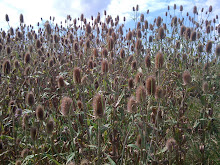In May 2011, I attended McGill Graduate Group for Feminist Scholarship's conference, (Dis)embodied Feminisms: New Perspectives on Gender, Sexuality, and Identity.
The keynote speaker was by Brooklyn-based performance artist Amber Hawk Swanson (http://amberhawkswanson.com).
The paper I presented was entitled:
"Pleasure and Autonomy: Masturbation in the Embroidery of Ghada Amer"
This paper examines the ways in which masturbatory imagery in the embroidery of Ghada Amer (b.Egypt 1963) evokes a dialogue on the representation of female pleasure and the critical potential of sexual autonomy, while at the same time her work generates cultural and historical opposition. I shall interrogate Amer’s constructions of female sexualities by discussing the juxtaposition of imagery and media in, for example, La Ligne (1996) and Pink (2000) where female figures appropriated from soft-core pornography are reproduced in embroidery - a medium still predominantly associated with feminine labour. Amer’s work functions as a response to various cultural oppressions and historical art precedents. Written from a feminist perspective, I shall consider the diversity of Amer’s cultural background and her re-presentation of the female body in order to explore a nuanced understanding of her work. With the denial of both man and machine, the self-gratifying form displays no need for assistance in order to attain sexual fulfillment. As Thomas W. Lacquer (2003) suggests, masturbation is democratically accessible and freely attainable - regardless of gender, class or race. Amer’s masturbatory figure might then function as a liberating gesture in art production and the representation of pleasure. Considering her work in this manner allows us to expand contemporary understandings of the act and its representation.
This paper examines the ways in which masturbatory imagery in the embroidery of Ghada Amer (b.Egypt 1963) evokes a dialogue on the representation of female pleasure and the critical potential of sexual autonomy, while at the same time her work generates cultural and historical opposition. I shall interrogate Amer’s constructions of female sexualities by discussing the juxtaposition of imagery and media in, for example, La Ligne (1996) and Pink (2000) where female figures appropriated from soft-core pornography are reproduced in embroidery - a medium still predominantly associated with feminine labour. Amer’s work functions as a response to various cultural oppressions and historical art precedents. Written from a feminist perspective, I shall consider the diversity of Amer’s cultural background and her re-presentation of the female body in order to explore a nuanced understanding of her work. With the denial of both man and machine, the self-gratifying form displays no need for assistance in order to attain sexual fulfillment. As Thomas W. Lacquer (2003) suggests, masturbation is democratically accessible and freely attainable - regardless of gender, class or race. Amer’s masturbatory figure might then function as a liberating gesture in art production and the representation of pleasure. Considering her work in this manner allows us to expand contemporary understandings of the act and its representation.


























.jpg)
.jpg)
.jpg)
.jpg)
.jpg)




